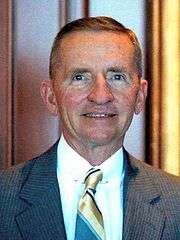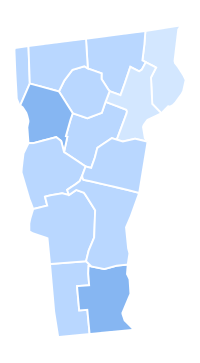United States presidential election in Vermont, 1992
| | |||||||||||||||||||||||||||||||||||||||
| |||||||||||||||||||||||||||||||||||||||
| |||||||||||||||||||||||||||||||||||||||
|
| |||||||||||||||||||||||||||||||||||||||
| County Results
Clinton—50-60%
Clinton—40-50%
Clinton—<40% | |||||||||||||||||||||||||||||||||||||||
| |||||||||||||||||||||||||||||||||||||||
The 1992 United States presidential election in Vermont took place on November 3, 1992, as part of the 1992 United States presidential election. Voters chose three representatives, or electors to the Electoral College, who voted for President and Vice President.
Vermont was won by Democratic Governor Bill Clinton of Arkansas, taking 46.11% of the popular vote over incumbent Republican President George H.W. Bush of Texas, who took 30.42%, a victory margin of 15.70%. Independent Texas billionaire Ross Perot finished in third with 22.78% of the popular vote.[1] Clinton ultimately won the national vote, defeating incumbent President Bush.[2]
This election would prove to be a re-aligning one for the state of Vermont. Clinton's decisive double-digit victory in the state, including a Democratic sweep of all fourteen counties, represented a dramatic turnaround for a state that up to that point had been reliably Republican for over 130 years. This was only the second time in history that a Democratic presidential nominee had won Vermont's electoral votes, the first and only prior time being when Lyndon Johnson had carried the state in the 1964 Democratic landslide. Except for 1964, Vermont had voted Republican in every presidential election from 1856 to 1988. Beginning in 1992, however, Vermont instantly became a reliably Democratic state in presidential elections, voting Democratic in every election that has followed.
Vermont's sudden shift away from the GOP was largely a product of dramatic changes within the party itself. By the 1990s, the Republican Party, which once had a vibrant progressive Northeastern wing, had been almost completely taken over by conservatives, Southerners, and Evangelical Christians. Consequently, Vermont, a liberal and secular New England state, moved increasingly toward the Democratic Party and today is regarded as one of the bluest of blue states.
Results
| United States presidential election in Vermont, 1992[1] | |||||
|---|---|---|---|---|---|
| Party | Candidate | Votes | Percentage | Electoral votes | |
| Democratic | Bill Clinton | 133,592 | 46.11% | 3 | |
| Republican | George H.W. Bush (incumbent) | 88,122 | 30.42% | 0 | |
| Independent | Ross Perot | 65,991 | 22.78% | 0 | |
| Libertarian | Andre Marrou | 501 | 0.17% | 0 | |
| Write-ins | 488 | 0.17% | 0 | ||
| New Alliance | Lenora Fulani | 429 | 0.15% | 0 | |
| Natural Law | Dr. John Hagelin | 315 | 0.11% | 0 | |
| VT Taxpayers' | Howard Phillips | 124 | 0.04% | 0 | |
| Socialist Workers | James Warren | 82 | 0.03% | 0 | |
| Democrats for Economic Recovery | Lyndon LaRouche | 57 | 0.02% | 0 | |
| Totals | 289,701 | 100.0% | 3 | ||
References
- 1 2 "1992 Presidential General Election Results - Vermont". U.S. Election Atlas. Retrieved 10 June 2012.
- ↑ "1992 Presidential General Election Results". U.S. Election Atlas. Retrieved 10 June 2012.




.svg.png)
